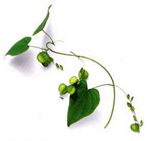
Wild Yam
Introduction
This fact sheet provides basic information about Wild Yam. Dioscorea villosa is a twining vine native to the central southeastern US and found less frequently in the Appalachian region. It is a dioecious plant with inconspicuous white to greenish yellow female flowers and smooth heart-shaped leaves. A Chinese species, Dioscorea opposita Thunb., is also occasionally found in herbal commerce. There are more than 500 species of Dioscorea worldwide.Wild yam was popularized by the Eclectic medical movement in the 19th century for its supposed antispasmodic properties and prescribed for biliary colic and spasm of the bowel. More recently, it has been promoted for the relief of nausea in pregnancy, and for amenorrhoea and dysmenorrhea. Further indications have been reported for urinary tract infections, rheumatoid arthritis, cholera, nervous excitement, and gas expulsion.
Common Names
Wild Yam, Wild Yam Root, Colic Root, Yuma, Devil's Bones, Rheumatism Root, China RootLatin Names
Dioscorea villosaWhat It Is Used For
- Dioscorea has been promoted for the treatment of menstrual dysfunction, nausea in pregnancy, urinary tract infections, rheumatoid arthritis, cholera, nervous excitement, and gas expulsion. However, research reveals no clinical data regarding the use of wild yam for any condition.
How It Is Used
It has been suggested to take 1 to 2 tsp three times of day of the dried wild yam herb. As tincture take 2 to 4 mL three times daily. Use in children should be limited to only 1 week according to some health professionals. Always make sure to adjust the recommended adult dose to account for the child's weight.What the Science Says
- Research reveals little or no information regarding toxicology with the use of wild yam.
Side Effects and Cautions
- In large doses, D. villosa root may cause nausea, vomiting, and diarrhea.
Sources
- Drugs.Com Web site. Accessed on February 7, 2009.
- From Wikipedia, the free encyclopedia. Accessed on February 7, 2009.






